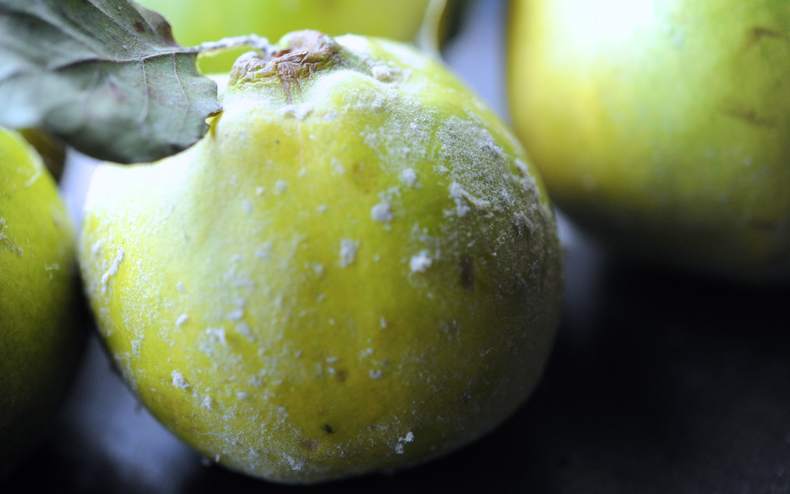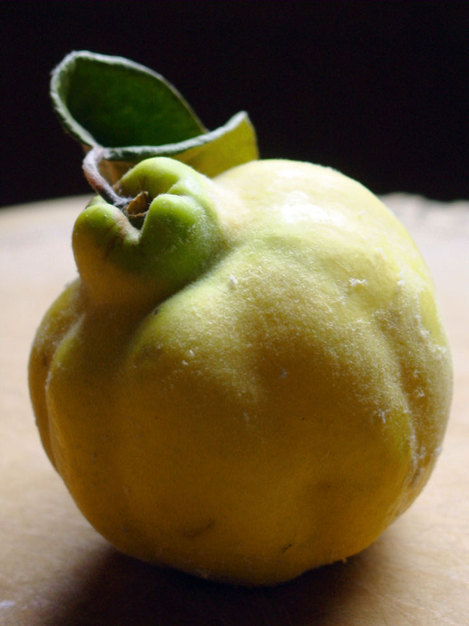There are few things more magical than a quince. With a little kitchen alchemy you can transform this forbiddingly astringent and fuzzy fruit into something silken and sublime. The tip-off is the fragrance. When ripe, a quince will lose any hint of green, turn golden yellow and emit the most extraordinary aroma, like a candied combination of guava, pear and vanilla. I've heard that, left to ripen on the tree until late fall, they can actually become sweet enough to eat out of hand, but I have never encountered such a specimen. So I've always cooked them, generally poaching or roasting them in sweet preparations, or braising them with savory meats. If you've never tried a quince, now is the moment to look for them at your local farmers market. You'll have to look hard, though. Even at New York City's Union Square market, I found only one vendor with quinces. I wrote about this beguiling fruit here, way back in the very early days of the blog, and then again here, where I included recipes for making quince paste and for Alice Waters' mouth-watering quince and lamb tagine. This week I found a recipe for a hot lamb and quince salad from Hugh Fearnley-Whittingstall—he of the River Cottage and the exceedingly long name—and it really struck my fancy. Maybe it will strike yours, too.
Read More...
Twitter @glutton4life
11.28.11 The Original Apple
When I was growing up, every 7 years my family lived in Spain. My father was a professor of Spanish literature, and he spent his sabbaticals doing research, writing and collecting the Sephardic ballads that were his specialty. The year I turned 15 there, my sisters (5 and 7 years older than I) were already out of the house, so I was essentially an only child. I went everywhere with my parents, which meant a very diverse cultural life (opera, theater, dance, symphony, museums, galleries), lots of meals out and visits to some very fancy Madrid residences. Perhaps because we were in Europe—or maybe it had something to do with the almost exclusively adult company—the rules relaxed a bit and I was often allowed a glass of sherry, cointreau or vino tinto. This set the stage for expanding my appetite, too, and I tried many unknown delicacies: octopus, white asparagus, kidneys, membrillo. The latter was a deep-amber-colored jelly that was often brought out with the cheese course (another novelty), a sticky, sweet confection to pair with the rich oily Manchego. At the time, I had never seen a quince, and it's a bit of a leap anyway from that fuzzy, essentially inedible fruit to this jammy nectar of the gods.
Read More...
Read More...
11.10.09 Quince a la Alice
It is thought that the quince—and not the apple—is actually the fruit being referred to in the Song of Solomon; the one that caused Atalanta to pause in her fateful race; perhaps even the fruit of paradise. Today, in this country, the quince is not widely known, and is available primarily at specialty or farmers markets. It ripens in September and October but can often be found through December. The quince's gorgeous perfume, sweet and floral, belies its astringent taste and hard texture, which is sometimes covered with a sparse, velvety fur. But roasted, baked or stewed and always sweetened, quince takes on a rich, rosy color and a deliciously complex flavor, like an apple or pear but with hints of guava and pineapple. Most often seen as a paste to accompany Manchego cheese or in jams and jellies, Alice Waters offers this simple poaching recipe.
Read More...
Read More...










